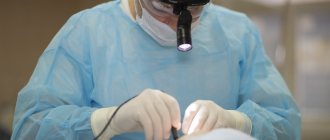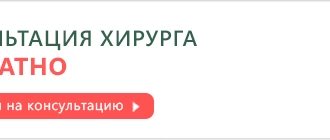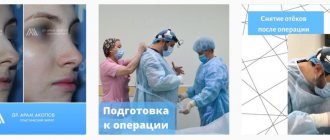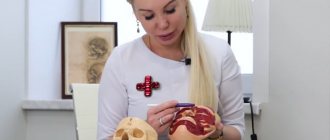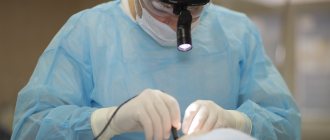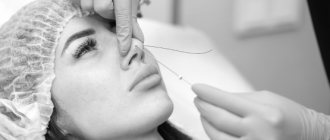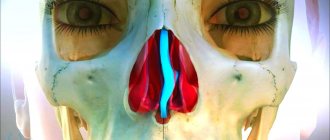Deviated nasal septum
Deviation of the nasal septum (ICD code 10) is a natural or acquired persistent displacement of the bone or cartilaginous structures of the nasal septum, accompanied by impaired nasal breathing (“Otorhinolaryngology” V.T. Palchun, Moscow, 2007) The
nasal septum consists of cartilage and bone structures , dividing the nasal cavity into two relatively equal halves, and shapes the direction of air flow inside the nose. Thanks to this, the normal formation of free nasal breathing occurs, the inhaled air is warmed and moistened, other protective functions of the nose work normally, and the sense of smell is formed.
Curvature can arise either as a result of a direct injury to the nose, or appear gradually during a person’s growth; many see the cause of significant curvatures in injuries to the nose in early childhood - falls, birth injuries, but it seems unlikely to prove this due to the long development time.
Prominent ridge of the nasal septum
Impaired nasal breathing can have a very negative impact on the human body. Lack of nasal breathing and even just constant breathing through the mouth leads to hypoxia (oxygen starvation) and not only affects well-being, but contributes to the development of a number of pathological changes.
The nervous, cardiovascular, and hematopoietic systems react most strongly to oxygen starvation; a significant effect on the human hormonal system is possible. Patients with chronic lung diseases can be very sensitive to air quality, which is determined precisely by proper nasal breathing. After all, our nose not only breathes, but also cleans, warms and humidifies the air so that it does not irritate the respiratory tract and lungs of a person. The growing bodies of children, patients suffering from chronic diseases of the lungs and cardiovascular system, people under conditions of heavy physical activity, constant stress, and intense mental activity are very sensitive to oxygen starvation.
Prominent ridge of the nasal septum The entrance to the nose is narrowed by the curvature of the septum so much that it cannot be passed through with an endoscope
Indications
Correction of the nasal septum is resorted to for several reasons:
- curvature of the nose (deformations of the septal part are visually noticeable to others and can cause psychological complexes);
- nasal congestion (sometimes it spreads to two nostrils at once, forcing a person to breathe through the mouth, which leads to changes in the bite and other orthodontic anomalies);
- frequent respiratory diseases accompanied by rhinitis, as well as inflammatory processes in the sinuses, pharynx, etc.
The patient's physical condition may also be aggravated by headaches, spontaneous nosebleeds and other symptoms.
Surgery to correct the nasal septum
Correction of a deviated nasal septum is carried out only surgically. The operations are called septoplasty or submucosal resection of the nasal septum. Septoplasty - what is it? Sometimes this type of operation is combined with correction of the external nose and is part of rhinoseptoplasty. Before and after photos will help you understand more clearly what nasal septoplasty looks like.
It is important to understand that operations are carried out to eliminate functionally significant disorders, that is, leading to the development of pathologies that cause complaints in the patient or hidden problems in his body. Minor deviations of the nasal septum that do not cause problems with nasal breathing or contribute to the development of other pathologies are usually not subject to surgical correction.
Normal nasal septum - minor curvatures Smooth septum after septoplasty
The purpose and course of the operation is to highlight the curved bone and cartilaginous structures of the nasal septum, partially remove it, and straighten the remaining part as much as possible, while preserving the mucous membrane covering the nasal septum, leaving intact or restoring the supporting parts of the nasal septum. Access is through the patient's nostrils. There are no external incisions, so the operation leaves no visible scars. Septoplasty of the nasal septum does not change the external shape of the nose, so this intervention is invisible to others.
To perform the operation, predominantly a “cold” instrument (scalpel, etc.) is used. Laser and radio frequency technologies popularized among the masses are auxiliary.
They are used primarily for correcting nasal turbinates, sometimes making incisions in the nasal septum or working with cartilage, and stopping bleeding. In the vast majority of cases, complete correction of the nasal septum requires work with bone structures, where laser or other destructive-coagulation technology has no advantage. Nevertheless, we often encounter patients who insist on laser correction of the nasal septum, fully confident that this is the only modern method, and a cold instrument is a thing of the past. Unfortunately, this is not so, one might even say the opposite. Possessing excellent hemostatic (hemostatic) properties due to high temperature exposure, the laser burns or “welds” tissue and still cannot come close to a well-sharpened scalpel in terms of cleanliness of the incision and healing time. The world's leading clinics “still” use classical instruments when working on the nasal septum, and their standards do not include the mandatory use of a laser during surgery on the nasal septum. But in defense of the laser, we can say that it is very convenient for operations on the nasal turbinates due to its hemostatic effect, although there are many other techniques that are no less effective, such as electrical and thermal effects (including cryocoagulation, popular in Russia), and the use of ultrasound , radiofrequency methods of surgery.
There are techniques for operating on the nasal septum using a special video camera - an endoscope, which is also an option rather than a necessity.
The choice of additional equipment during surgery (endoscope, laser, radiofrequency coagulator) falls entirely on the shoulders of the specialist, not the patient. An incorrectly or inappropriately used instrument will not only not help, but will also complicate the operation. Only the surgeon knows how much this or that instrument will help him in performing the operation.
Almost always, surgery on the nasal septum (before and after photos) is combined with simultaneous correction of other intranasal structures - the turbinates.
These formations of the nasal cavity greatly affect nasal breathing, and their improper functioning can lead to the development of the pathology “Vasomotor rhinitis”. With a deviated nasal septum, the nasal turbinates often take the shape of its curvature and become asymmetrical. In this case, even with their normal functioning without correction, it is difficult to achieve good nasal breathing only through surgery on the nasal septum. Since one-time correction of the nasal turbinates and nasal septum is used everywhere, doctors often talk about correction of the nasal septum, meaning one-step correction of these structures as well. In some institutions, work with the nasal turbinates is immediately included in the cost of the operation, while in others it may be a separate item. But it is still inseparable from surgery on the nasal septum to restore good nasal breathing.
How to get rid of this defect?
Non-surgical ways to correct a crooked nose are usually either ineffective or simply dangerous. In case of damage only to cartilaginous structures, minor deviations can be eliminated after heating the cartilage with a laser. But manual “home” methods using brute force are generally prohibited, since at best they lead to a re-fracture and heavy bleeding.
Of course, you can mask the problem. Many beauty websites will tell you how to hide a crooked nose with makeup. But, of course, this will not correct the anatomical defect.
Surgical interventions have been and remain the most effective way to eliminate nasal deformities. These can take the form of micro-surgeries, such as injections of hyaluronic acid fillers, which will add missing volume to specific areas of the nose. Their disadvantage is their temporary effect and the ability to correct relatively minor curvatures.
But the most effective operation for a crooked nose is rhinoplasty. Almost always it involves straightening the nasal septum. The main advantage of rhinoseptoplasty is the preservation of the result for life and the ability to accurately adjust the shape of the nose in accordance with the wishes of the patient.
Types of anesthesia
The operation is performed only under general anesthesia - general anesthesia.
- This type of anesthesia is more gentle on the patient’s mental state.
(the patient is asleep, does not feel anything and has good dreams

